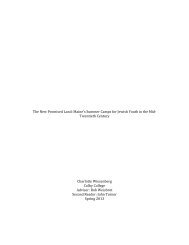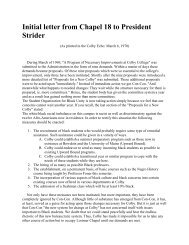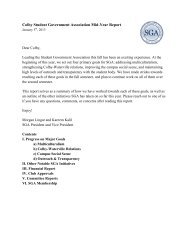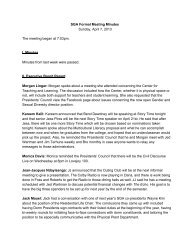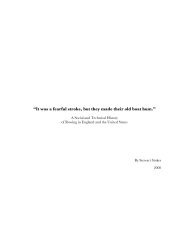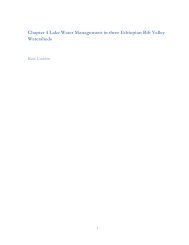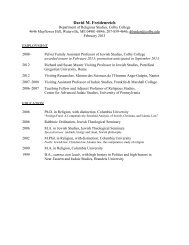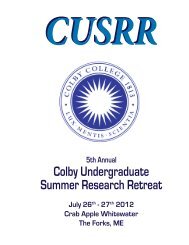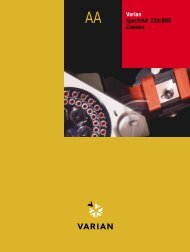CH 331 CA-EDTA LAB 2012
CH 331 CA-EDTA LAB 2012
CH 331 CA-EDTA LAB 2012
You also want an ePaper? Increase the reach of your titles
YUMPU automatically turns print PDFs into web optimized ePapers that Google loves.
COMPLEXOMETRIC DETERMINATION OF <strong>CA</strong>LCIUM WITH <strong>EDTA</strong><br />
In this experiment you will determine the concentration of Ca +2 in an unknown solution by<br />
complexing it with an excess of <strong>EDTA</strong>. The excess <strong>EDTA</strong> will be titrated with a standard solution of<br />
Zn +2 . Since you will be controlling the total moles of <strong>EDTA</strong> added in the first place, you will be able to<br />
calculate the moles of Ca +2 in the sample aliquot by the difference between the total moles of <strong>EDTA</strong> added<br />
and the amount that is left to react with the Zn +2 . This approach of deliberately adding an excess of one<br />
reagent (in this case, <strong>EDTA</strong>) and titrating the excess with another standard solution is known as a "back<br />
titration". It is often used when the conditions for the direct titration are not ideal. For example, Al 3+ is<br />
frequently determined by back titration since <strong>EDTA</strong> reacts slowly with Al 3+ . If we tried to titrate Al 3+<br />
directly with standard <strong>EDTA</strong> we would easily overshoot the endpoint (or have to wait a tediously long time<br />
between tiny increments of titrant). In the case of the Ca +2 determination that we are doing this week, the<br />
Ca +2 releases the indicator that we will be using (Eriochrome Black T) too sluggishly to give a sharp<br />
endpoint. Chelating the Ca +2 with <strong>EDTA</strong> before adding the indicator avoids that problem. (The indicator<br />
reacts quickly with Zn +2 .)<br />
The disadvantage to back titrations is that you need two standard reagents, the <strong>EDTA</strong> and Zn +2<br />
solutions in this case. Fortunately, the Zn +2 solution can be prepared in sufficient purity from reagent<br />
grade zinc metal that it will not need to be standardized. The <strong>EDTA</strong> solution will be standardized by<br />
titrating aliquots with the standard Zn +2 solution.<br />
Standard Zinc solution. 0.02 M. Treat about 1 gram of reagent grade Zn granules with about 20 ml of<br />
2.5 M HCl for a short time. (You want to remove the oxide film which should be easy in this solution. A<br />
little fizzing will occur due to the attack of the HCl on the metal.) Pour out the HCl before much of the<br />
zinc has dissolved. Wash the Zn several times with deionized water. Then dry by washing several times<br />
with small quantities of methanol and finally with ether. After pouring off the ether (into a waste container<br />
in the hood) stir with a glass rod to evaporate the solvent from the zinc. Weigh 1.2 g of this metal by<br />
difference and transfer it directly into a 1000 ml volumetric flask. (Record the mass to at least 4<br />
significant figures.) Dissolve the metal in a minimum amount of 8 M HNO3. Bring the solution to the<br />
1000 ml mark with deionized water. Mix thoroughly.<br />
<strong>EDTA</strong> solution. 0.01 M. Weigh approximately 1.8 g of the disodium, dihydrate salt of <strong>EDTA</strong> into a 150<br />
ml beaker (using the open pan balance). Use deionized water to form a slurry and transfer the <strong>EDTA</strong> to a<br />
500 ml volumeteric flask. Bring to the mark with deionized water and mix thoroughly. (<strong>EDTA</strong> is slow to<br />
dissolve, so check to see that all of the crystals have disappeared.) Transfer this solution to a clean plastic<br />
bottle.<br />
Standardizing the <strong>EDTA</strong> solution. After thoroughly mixing the <strong>EDTA</strong> in the bottle, rinse a clean 150 ml<br />
beaker 3 times with <strong>EDTA</strong> solution and then fill the beaker. Pipet 25.00 ml <strong>EDTA</strong> from the beaker into a<br />
200 ml Erlenmeyer flask. Add 5.00 ml of ammonium buffer (pH 10), 5.00 ml of deionized water and 3<br />
drops of Eriochrome Black T indicator. (The indicator is blue in the presence of excess <strong>EDTA</strong> and pink in<br />
the presence of excess metal. ) Pipet 2.00 ml of this solution into a 1 cm cuvette and add a small stir bar.<br />
Titrate with the standard zinc solution using a Logger Pro titration system and your home-built colorimeter.<br />
Plot absorbance versus titrant volume to determine the endpoint. Obtain three reproducible titrations.<br />
Calcium Determination. (about 0.01 M) Bring the unknown solution to the mark with deionized water<br />
and mix thoroughly. Rinse a clean beaker at least three times with this solution and then fill it with the<br />
calcium solution. Clean a 10.00 ml pipet and rinse several times with the sample calcium solution from the<br />
beaker. Refill the beaker and pipet 10.00 ml calcium solution into a clean 200 ml Erlenmeyer flask. Pipet
50.00 ml of your standardized <strong>EDTA</strong> solution into the same flask. Then add 5.00 ml of ammonium buffer.<br />
Mix for a few seconds by swirling and then add 3 drops of Eriochrome Black T indicator. Pipet 2.00 ml of<br />
this solution into a 1 cm cuvette and add a small stir bar. Titrate the excess <strong>EDTA</strong> with the standard zinc<br />
solution. Obtain 3 reproducible titrations.<br />
Report. Calculate the concentration of calcium in the sample solution. Turn in your data and a sample<br />
calculation with a typical titration plot. Express the average (of your best values) Ca +2 concentration both<br />
in molarity and in ppm calcium.



